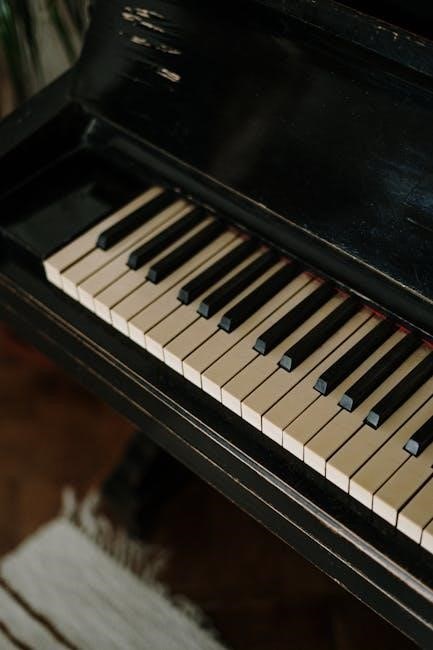Acordes de Piano PDF: Guía Completa
Embark on a musical journey with our comprehensive piano chords guide! This resource offers a wealth of information to help you understand, play, and master piano chords. From basic chord structures to advanced techniques, you’ll find everything you need!
Introducción a los Acordes de Piano
Welcome to the exciting world of piano chords! This introduction will lay the foundation for your chord-playing journey. Piano chords are fundamental building blocks in music, essential for creating harmonies and accompanying melodies. Understanding chords opens up a vast landscape of musical expression and creativity.
Whether you are a complete beginner or have some experience with the piano, this guide will provide you with the knowledge and resources you need to learn and master chords. We will start with the basics, explaining what chords are, how they are constructed, and why they are so important in music.
Through clear explanations and practical examples, we will explore the different types of chords, including major, minor, seventh, and more. You’ll also learn how to read chord diagrams and apply them to real songs. Get ready to unlock the power of chords and elevate your piano playing to new heights!
¿Qué es un Acorde?
At its core, a chord is simply a combination of three or more musical notes played simultaneously. These notes, when sounded together, create a harmonic unit that forms the basis of most Western music. Think of chords as the colors on a painter’s palette, allowing you to create a wide range of musical textures and emotions.
The specific notes that make up a chord determine its quality, such as major, minor, or diminished. Each chord type evokes a different feeling and is used to create specific moods and effects in music. Chords provide the harmonic backdrop for melodies, adding depth and richness to musical compositions.
Understanding the structure of chords is crucial for any aspiring musician. By learning how chords are formed and how they function within a song, you’ll gain the ability to play, compose, and analyze music with greater confidence and creativity. This section will delve deeper into the building blocks of chords, setting the stage for exploring more complex chord types and progressions.
Tipos de Acordes Básicos (Mayor, Menor)
The foundation of chord knowledge lies in understanding the two most fundamental types: major and minor chords. These chords are the building blocks of countless songs and musical pieces across various genres.
A major chord generally evokes a bright, happy, or uplifting feeling. It consists of the root note, a major third, and a perfect fifth. For example, a C major chord is made up of C, E, and G.
In contrast, a minor chord typically creates a darker, sadder, or more melancholic mood. It comprises the root note, a minor third, and a perfect fifth. A C minor chord, for instance, consists of C, Eb (E flat), and G.
The difference between major and minor chords lies solely in the interval of the third. This seemingly small change dramatically alters the chord’s emotional impact. Mastering these basic chord types is essential before moving on to more complex chord variations. This section will provide detailed diagrams and explanations of major and minor chords in all twelve keys.

Descarga de Guías y Diccionarios de Acordes en PDF
Access a vast library of piano chord knowledge! Download comprehensive guides and dictionaries in PDF format to enhance your learning experience and expand your musical capabilities. Unlock the power of chords!
Recursos Gratuitos y de Pago
Explore a diverse range of resources to suit your learning preferences and budget. Numerous websites offer free PDF guides and chord charts, providing a solid foundation for beginners. These resources often cover basic chords, scales, and simple progressions, allowing you to start playing quickly.
For more in-depth learning and advanced techniques, consider investing in paid resources such as comprehensive chord dictionaries, interactive courses, and personalized lessons. Premium resources often feature detailed explanations, practice exercises, and access to experienced instructors.
Whether you choose free or paid resources, remember that consistent practice and dedication are key to mastering piano chords. Utilize the available materials effectively and supplement your learning with online tutorials, sheet music, and collaboration with other musicians. The path to musical proficiency is paved with consistent effort and a passion for learning.
Evaluate your needs and learning style to determine the most suitable resources for your journey. Both free and paid options offer valuable tools to unlock your potential. Embrace the learning process and enjoy the fulfilling experience of playing the piano.
Importancia de la Digitación en los Acordes
Proper fingering, or “digitation,” is crucial for smooth and efficient chord playing on the piano. Correct digitations allow for seamless transitions between chords, enabling you to maintain a steady rhythm and avoid awkward hand movements.
Using recommended fingerings in chord diagrams ensures that your hand is positioned optimally for playing subsequent chords. This reduces strain and fatigue, allowing you to practice for longer periods without discomfort. Furthermore, consistent use of proper digitations builds muscle memory, making chord changes more fluid and natural over time.
Experiment with different fingerings to find what works best for your hand size and playing style. However, be mindful of the recommended digitations in your PDF chord guides, as they are designed to optimize efficiency and minimize strain. Mastering correct digitations will significantly enhance your playing ability and unlock new levels of musical expression on the piano.
Focus on developing good habits from the beginning to create a solid foundation for your piano journey. Correct fingering is the key to effortless chord playing.

Cómo Leer Diagramas de Acordes de Piano
Understanding piano chord diagrams is essential for learning new chords. These diagrams visually represent the piano keyboard and the notes that make up each chord, simplifying the learning process significantly. Let’s delve into how to read them!
Entendiendo la Representación Visual de los Acordes
Piano chord diagrams are your roadmap to musical harmony. They offer a visual shortcut, allowing you to quickly grasp the finger positions for various chords. Think of them as simplified maps of the piano keyboard, designed to make learning more accessible.
Typically, a chord diagram depicts a segment of the keyboard, usually spanning one to two octaves. The horizontal lines represent the keys, with white keys shown as blank spaces and black keys indicated by darker rectangles. Dots are placed on the lines to show you where to position your fingers.
Numbers often accompany these dots, indicating which finger should be used for each note. Remember, 1 represents your thumb, 2 is your index finger, 3 is your middle finger, 4 is your ring finger, and 5 is your pinky.
The name of the chord is usually displayed above the diagram, along with any additional symbols like “m” for minor or “7” for a seventh chord. By understanding these elements, you can quickly decode any chord diagram and apply it to your playing.
Mastering the art of reading chord diagrams will empower you to learn new chords independently and expand your musical repertoire.
Acordes para Principiantes en PDF
Starting your piano journey can be exciting, especially when you have the right resources. PDF guides specifically designed for beginners are invaluable tools. These guides typically focus on the most essential chords that form the foundation of countless songs.
A beginner’s PDF will usually include major and minor chords in the key of C, G, D, A, E, F, and B flat. These keys are commonly used in popular music and provide a solid starting point for learning chord progressions.
The PDF will also explain how to read chord diagrams, which are visual representations of the keyboard showing you where to place your fingers. Clear finger numbering (1-5) is crucial for beginners, helping you develop proper technique.
Many beginner PDFs include simple songs or exercises using only a few chords, allowing you to immediately apply what you’ve learned. This hands-on approach is incredibly motivating and helps build muscle memory.
Look for PDFs that also cover basic music theory concepts, such as intervals and chord construction. Understanding the “why” behind the chords will make you a more well-rounded musician. With a good PDF guide, you’ll be playing simple songs in no time!

Aplicaciones Prácticas de los Acordes de Piano
Unlock your musical potential by applying piano chords in real-world scenarios. Learn to play chord progressions, accompany songs, and create your own music. The possibilities are endless with practical chord knowledge!
Progresiones de Acordes Comunes
Delve into the world of common chord progressions, the backbone of countless songs across genres. Understanding these progressions allows you to quickly learn and play familiar tunes and create your own compositions. A chord progression is a series of chords played in a sequence. These sequences often create a musical phrase or section within a song.
Some popular progressions include the I-IV-V, used extensively in blues and rock, and the ii-V-I, a staple in jazz. The I-V-vi-IV is another widely used progression, known for its pleasing and memorable sound. Explore variations within major and minor keys, experimenting with inversions and voicings.
Mastering common chord progressions provides a solid foundation for improvisation and songwriting. By recognizing and internalizing these patterns, you’ll gain a deeper understanding of music theory and unlock your creative potential. Use online resources and PDF guides to find lists of progressions, and practice them regularly. Don’t be afraid to experiment and find your own unique sound!
Acompañamiento de Canciones con Acordes
Learn the art of accompanying songs using piano chords, a skill that opens up a world of musical possibilities! With a solid understanding of chords, you can play along with your favorite tunes, create backing tracks, and even write your own songs.
Start by identifying the key of the song and finding the corresponding chords. Many songs use simple chord progressions, making them easy to accompany. Use a lead sheet or chord chart, which typically provides the lyrics and chord symbols above the words where the chord changes occur. Practice transitioning smoothly between chords, paying attention to rhythm and timing.
Experiment with different accompaniment styles, such as arpeggios, broken chords, or simple block chords. Add your own personal touch to the arrangement by incorporating variations and embellishments. Listen carefully to the melody and dynamics of the song to create an accompaniment that complements the vocals. With practice, you’ll be able to accompany virtually any song with confidence and creativity!

Recursos Adicionales para Aprender Acordes
Explore additional resources to deepen your understanding of piano chords! Discover helpful websites, books, and apps that can further enhance your skills and knowledge. Unlock your musical potential today with these fantastic resources!
Partituras con Acordes para Piano en PDF
Enhance your piano playing experience with a vast collection of sheet music featuring chords! These resources offer a practical way to learn and apply chord knowledge in real musical contexts. Downloadable PDF files provide convenient access to a variety of songs and musical pieces, all clearly marked with chord symbols.
Explore different genres, from classical to contemporary, and find sheet music tailored to your skill level. Whether you’re a beginner or an advanced pianist, there’s something for everyone. These sheet music resources are designed to help you improve your sight-reading, chord recognition, and overall musicality.
Many online platforms offer free and premium sheet music options. Take advantage of these resources to expand your repertoire and challenge yourself with new musical pieces. Look for sheet music that includes chord diagrams and fingerings to further assist your learning process. Start playing your favorite songs with accurate chords today!
These resources provide an excellent way to connect theory with practice, making learning chords more engaging and enjoyable. Happy playing!